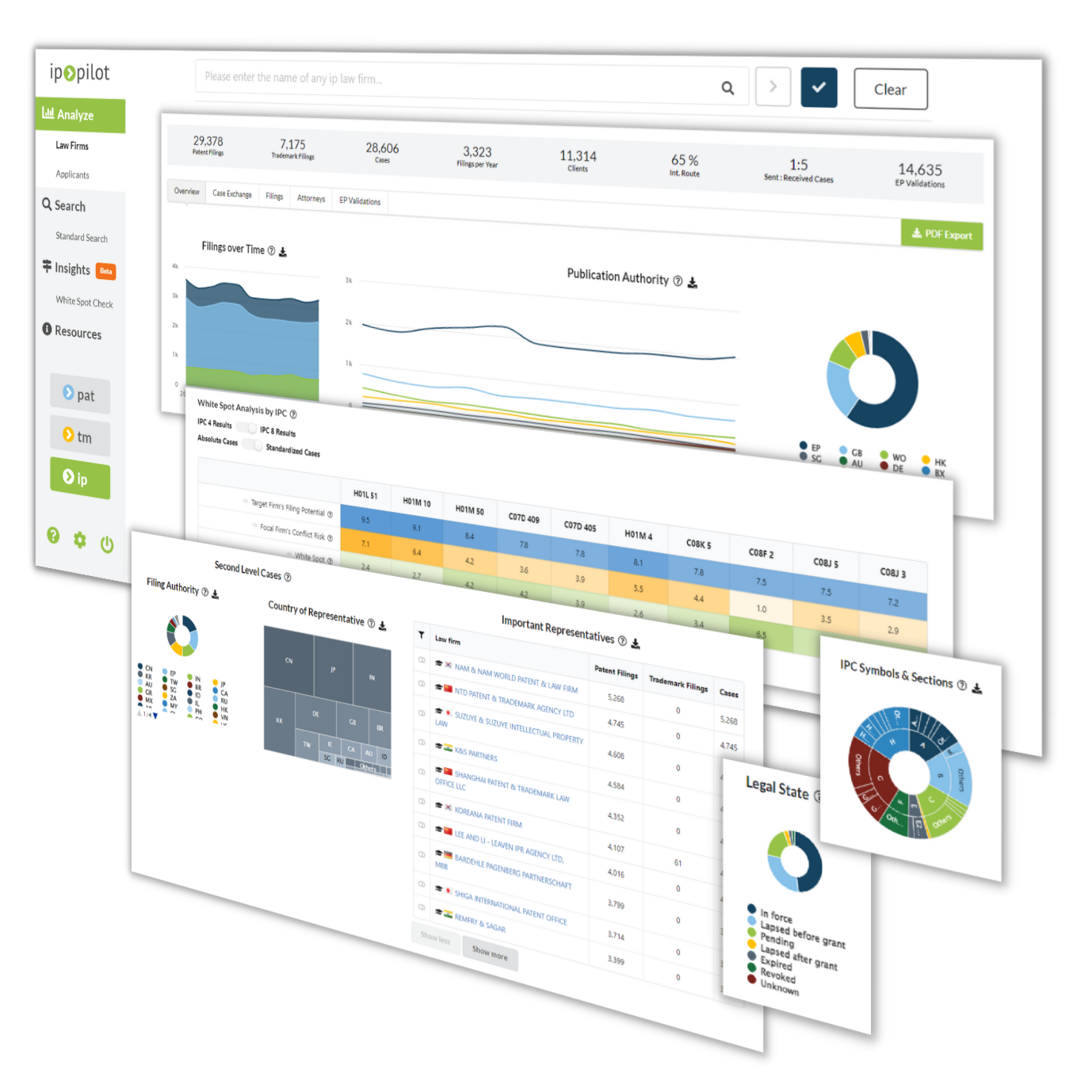As we head into 2025, the intellectual property (IP) industry faces an exciting yet challenging landscape. Filing trends are shifting, client priorities are evolving, and competitive pressures are mounting. For IP law firms—whether large, boutique, or somewhere in between—the question isn’t just how to adapt, but how to grow and develop your business as the landscape evolves.
The data experts here at IP Pilot have put together some invaluable insights into how filing data can help you to shape winning strategies for growth. Whether you’re a managing partner, associate, attorney, or business development professional looking to make a meaningful contribution to your firm’s growth, here’s your ultimate guide to identifying and turning these trends into actionable steps – because what else would you do if you had a glimpse into the future!
Zooming Out: Global Filing Trends and Macro Influences
Before diving into internal changes in your internal team and structure, it’s crucial to understand the macro, or prominent trends, driving filing behavior. Filing trends at the country and industry levels provide a wealth of information about client interests, emerging markets, and evolving technical demands.
Take South Korea as an example. According to IP Pilot data, IP filings from U.S.-based applicants have seen steady growth in recent years (see table below), signaling increased interest in this jurisdiction. Meanwhile, Japanese applicants remain key players, providing a stable source of work for many Korean IP firms.
Another crucial insight is the identification of specific technical fields that are driving filing growth. For example, electrical engineering and chemistry are two areas seeing consistent increases in filings in South Korea, particularly from foreign applicants. Firms that can identify these trends early and pivot their focus to match market demands will gain a significant advantage. By investing in attorneys with expertise in these high-growth fields or upskilling current teams, firms can capture emerging opportunities while strengthening their client offerings.
Actionable Insights for Firms:
- Focus on Growth Jurisdictions: If you’re based in Korea, the increasing activity from U.S. applicants should prompt you to evaluate your U.S. relationships. Are you fostering partnerships with key law firms and corporate clients in the U.S.? You might also consider establishing a dedicated U.S. desk or hiring professionals who understand the nuances of that market.
- Prepare for Industry Shifts: Filing trends show that certain technical fields—such as electrical engineering—are driving a significant portion of the growth in patent applications. This trend offers you a chance to align your technical expertise within your firm with market demand. For instance, hiring specialists in high-demand fields or investing in training programs to upskill your team can provide a competitive advantage.
- Use Data to Drive Strategy: Platforms like IP Pilot allows you to track macro trends, such as the influx of filings from specific countries or industries. By analyzing multi-year filing data, you can predict where future opportunities lie and plan accordingly.
Zooming In: Local Dynamics and Competitive Positioning
However, understanding global trends is only one lever firms can pull. To compete effectively, firms must also evaluate their position within the local market. Who are your key competitors? What strategies are the leading firms adopting? And where does your firm stand in the rankings?
For example, leading Korean firms like Kim & Chang and Lee International have built strong relationships with U.S. and Japanese firms, often directly partnering with corporate IP departments like Bosch and Bristol-Myers. This gives them a consistent pipeline of work while reducing dependency on intermediary firms.
How to Apply This Insight:
- Benchmark Against Your Local Market: Identify who is around you. Use tools to compare your firm’s performance against top competitors. Identify who their key clients and sending associates are, and evaluate how your client portfolio compares to your competition.
- Not up against the big fish? Target Mid-Sized Firms: If you’re not competing with the biggest firms in the league, you can focus on mid-sized firms that operate in the same volume range as you. For example, adding constraints to analyze firms receiving 100–500 cases over a five-year period can help you identify like-for-like firms and refine your strategy to give you an edge.
- Find Market Holes and Diversify Your Network: Firms that rely solely on one or two jurisdictions for work are at greater risk of losing their place in the market. By analyzing filing data, you can identify underexplored markets and form relationships with associates and applicants in those regions.
Where to Start?
We’ve put together a series of recommendations to help your firm turn insights into actions. Here’s how to get started:
- Find Friends and Expand Your Relationships: Filing trends indicate increasing activity from certain countries and sectors. Focus on building relationships in these areas—whether through attending jurisdiction-specific conferences, hosting client events, or leveraging your firm’s existing network.
- Invest in Your Team and Strengthen Your Technical Bench: Consider hiring or training attorneys with expertise in high-growth fields like electrical engineering. This not only allows you to capture more market share but also strengthens your value proposition to potential clients.
- Evaluate Your Networking Strategy: The right conferences can be game-changers for business development. IP Pilot’s curated list of global events for 2025 is a great starting point for identifying opportunities to meet key associates and applicants.
- Be Bold and Explore Direct Client Relationships: Some firms have successfully cultivated direct relationships with applicants, bypassing intermediary firms. This model allows for greater flexibility, higher margins, and a closer understanding of client needs.
- Gain a Competitive Advantage and Invest in Technology: Data-driven decision-making for business development is no longer optional. Tools like IP Pilot provide insights into filing trends, client behaviors, and competitive dynamics, allowing your firm to make smarter, faster decisions.
What is Your Future?
In today’s rapidly evolving IP landscape, firms that seek out and utilise filing trends and align their strategies accordingly are the ones who gain an edge and are set up for growth. By analyzing macro influences, understanding local market dynamics, and optimizing internal resources, your firm can stay ahead of the competition.
As you finalize your strategy, remember: the future belongs to firms that are proactive, data-driven, and adaptable. Whether it’s deepening relationships in emerging markets, hiring specialists in high-demand fields, or leveraging cutting-edge tools, the opportunities are there for those willing to seize them.
WHAT
Allows users to create a personalized dashboard within the Entity Profile, displaying the most relevant charts and information in a new tab.
WHY
Useful to avoid clicking and switching between tabs on the same profile
HOW
- Go to profiles and click on tab menu to create a new Custom View
- Select the charts to be added to the view
WHAT
Allows a grouped view of the portfolios of all connected entities at once.
WHY
Useful to avoid selecting various companies of the same group one by one, or missing an entity.
HOW
- Switch to group view in the sidebar
- Start an entity search on applicants
- On the name search, now grouped entities will be listed as their group name only
WHAT
Part of the Search feature that provides a detailed list of filings related to the search previously stated.
WHY
Useful if you want to get details on filings for multiple entities at once, e.g. PCTs from Korea close to deadline.
HOW
-
Fill the form and run any search on the Search feature
- Switch results to “Filing View”
WHAT
Users can match entities from an Excel list against our database and provide specified information/fields for all entities in the list.
WHY
Instead of visiting profiles one by one, get the same information for various entities
HOW
-
Upload a list of applicants or firms or attorneys
- Check results of matching
- Select which information to fetch for all entities, e.g. no. of filings, top partners, etc.
WHAT
Allows users to analyze and contrast two entities side-by-side using customizable charts tailored to specific comparison criteria.
WHY
To make informed decision-making by analyzing key similarities and differences among entities.
HOW
-
Select either applicants or law firms
- Enter names of entities on both sides
- Select the charts to compare and hit search
WHAT
Gives you an immediate overview of similar firms or applicants.
WHY
Similar Entities help to identify alternative law firms/client to consider working with. It can also help to identify competitors.
HOW
-
Enter any applicant or law firm
- Add constraints, for example for countries
- Retrieve a list of similar entities and check the subcategories to understand why entities are considered to be similar
WHAT
Allows you to identify mutual partners and clients shared between two entities.
WHY
Discover new opportunities and business relationships. Firms current partners/clients can act as intermediaries, making introductions to entities with whom they already collaborate.
HOW
-
Enter any target applicant/firm as Entity A and yourself as Entity B
- Add constraints if needed
- Retrieve list of entities that both parties work with
WHAT
Identifies technical overlap, white spots, and fields with or without potential conflicts of interest between your firm, and another firm or applicant.
WHY
The feature helps to identify areas in which technological competences overlap. It can either be used to identify potential conflict of interests or overlaps in expertise.
HOW
-
Enter any two applicants or law firms
- See overlaps in technical areas and IPCs
- Identify clients in the overlapping fields
WHAT
Provides an overview of three key features from the broader Insights Section: Similar Entities, Network Overlap, and Tech Overlap. These tools offer valuable insights into connections, relationships, and case gaps between entities.
WHY
The Insights tabs simplify access to the 3 features and give users direct insights without filling out the form (separately).
HOW
-
On any profile, switch to the Insights tabs.
- If applicable, specify the firm to compare against.
- Switch to the actual feature (or Compare Entities) for more specific and filtered results.
WHAT
A highly flexible interface to define and build your own charts based on your firms needs.
WHY
Designed to enhance data visualization, this feature empowers users to present complex data in alignment with their goals, supporting informed decision-making and strategic planning.
HOW
-
Choose the visualization method
- Select the data fields
- Select constraints
- Retrieve charts on the data requested
WHAT
Provides a complete and organized view of an attorney’s profile, including filing stats, contact details and links to LinkedIn profiles.
WHY
To allow users to investigate and contact relevant people to meet.
HOW
-
As for applicants and law firms, simply enter any name in the entity search
- Load the profile
WHAT
Get details like addresses, LinkedIn profiles, website links for law firms as well as applicants. Also see connected entities.
WHY
To identify key contact details for networking, partnerships, and business development.
HOW
-
Load any profile
- Switch to the “About” tab
WHAT
Transfer information from IP Pilot directly to your CRM.
WHY
To simplify extraction of information, allowing to add entities from IP Pilot to CRMs.
HOW
-
Set up the connection in the IP Pilot Settings
- Specify the information to be transferred
- Transfer information by clicking “Push to CRM”
- Decide on how to handle conflicting information (if any exist)






